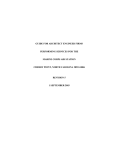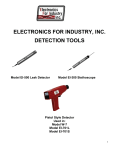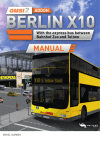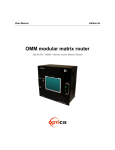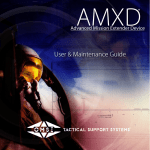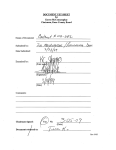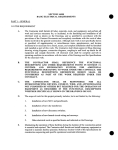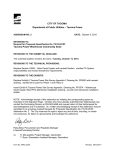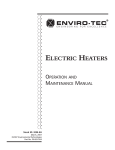Download Mechanical & Electrical Design Guide BCD
Transcript
SCHNEIDER ELECTRIC DESIGN GUIDE For ARCHITECTURAL ENGINEERS AND DESIGN/BUILD BUILD ENGINEERS & CONTRACTORS AUGUST 21, 2013 CHAPTER 1. GENERAL REQUIREMENTS 1.1 GENERAL This Design Guide including Attachments, by reference in the negotiated "Solicitation for Proposal", forms part of the Design/Build contract. The Design Guide provides policies, procedures and instructions applicable to Architectural Engineering and Design/Build Contracting firms performing design under contracts awarded by Schneider Electric. A-E shall be used to refer to both Architectural Engineering and Design/Build Contracting firms throughout this document. Division 01 of the Solicitation will indicate the specific required services and submittal requirements. 1.2 PRE-NEGOTIATION CONFERENCES The Design Build Contractor is invited, at their own option and expense, to attend Pre-negotiation meetings and conduct site visits to review and clarify the scope of work and to become acquainted with the project site. 1.3 CODES & STANDARDS Final design and installation shall conform to the following codes, standards, and guidelines: GSA P100-2010 GSA Smart Building Design and Implementation Guidelines U.S. Courts Design Guide ASHRAE Handbook of Refrigeration ASHRAE Handbook of HVAC Applications ASHRAE Handbook of HVAC Systems and Equipment ASHRAE Standard 15-2007: Safety Code for Mechanical Refrigeration ASHRAE Standard 52.2-2007: Method of Testing: General Ventilation Air-Cleaning Devices for Removal Efficiency by Particle Size ASHRAE Standard 55-2004: Thermal Environmental Conditions for Human Occupancy ASHRAE Standard 62.1-2007: Ventilation for Acceptable Indoor Air Quality, ASHRAE Standard 90.1-2007: Energy Standard for Buildings Except Low-Rise Residential Buildings, ASHRAE Standard 100-2006: Energy Conservation in Existing Buildings, ASHRAE Standard 105-2007: Standard Method of Measuring and Expressing Building Energy Performance, ASHRAE Standard 111-2008: Practices for Measurement, Testing, Adjusting and Balancing of Building HVAC Systems ASHRAE Standard 113-2005: Method of Testing for Room Air Diffusion ASHRAE Standard 135-2008: BACnet: A Data Communication Protocol for Building Automation and Control Networks ASHRAE Standard 180-2008: Standard Practice for inspection and Maintenance of Commercial Buildings ASHRAE Guideline 0-2005: The Commissioning Process ASHRAE Guideline #29-2009: Guideline for Risk Management of Public Health and Safety in Buildings SMACNA HVAC Duct Construction Standards: Metal and Flexible SMACNA HVAC Air Duct Leakage Test Manual SMACNA Fire, Smoke and Radiation Damper Installation Guide for HVAC Systems SMACNA Seismic Restraint Manual Guidelines for Mechanical Systems The latest edition of all National Fire Protection Association codes All applicable regulations and requirements of local authorities having jurisdiction CHAPTER 2. GENERAL PERFORMANCE REQUIREMENTS 2.1 General The A-E has the responsibility to ascertain what information is available from existing records of Schneider Electric’s client and what assistance can be provided by Schneider Electric. It shall be the responsibility of the A-E to obtain all additional information necessary to accomplish the work. 2.2 A-E Quality Assurance The contractual obligation of the A-E to provide professional quality, technical accuracy, and coordination of all designs, specifications and other services is extremely important and has far-reaching consequences. Ambiguity, omissions, and uncertainties on construction drawings and in specifications generally result in increased costs to Schneider Electric due to delays in construction as these errors and omissions are resolved and possible change orders when proper coordination between the work other subcontractors is not properly executed.. Liability for design errors and omissions will be pursued. The A-E is expected to conduct his/her own independent and thorough review of all plans and specifications and other required data prepared by the A-E and the A-E firms retained by other Schneider Electric subcontractors prior to any scheduled submittal to, or review by, Schneider Electric. This independent Quality Assurance review shall be for the purpose of eliminating errors, interferences, and inconsistencies between all design disciplines and the work of other subcontractors performing work on related Solicitations for Proposal, inconsistencies between drawings and specifications, and for the incorporation of criteria, review comments and guide specifications, as appropriate. 2.3 Schneider Electric Review Schneider Electric will not provide detailed checking and/or coordination services. A-E submittals will be reviewed by Schneider Electric only to the extent necessary to establish conformance with the Solicitation for Proposal and applicable design criteria. The A-E shall accept full responsibility for the technical accuracy and professional quality of all work and material which are furnished under a contract with Schneider Electric. 2.3 Liaison between A-E and Schneider Electric The A-E shall designate an individual who will be directly responsible for the design phase of the design/build project. Schneider Electric will assign a Project Manager (PM) representing Project Development and Engineering (PDE), a Construction Project Manager (CPM) representing Installation, a Construction Services Manager (CSM), and will identify a Technical Lead representing Project Development and Engineering (PDE). Technical liaison between the A-E and Schneider Electric will be through the Project Manager. Contractual liaison shall be through the Construction Services Manager. 2.4 Review Comments Resolution The A-E is responsible for the resolution and incorporation of Schneider Electric’s comments into the project design. The A-E, after reviewing and incorporating comments, shall return a copy of the comment sheet to the PM, annotated in the right hand column (clearly, if hand written) to indicate action taken, as well as returning any marked sheets with annotated responses. The responses shall include one of the following three (3) standard statements, plus clarifying remarks, explaining the rationale for the choice. a. Agree with comment. See sheet/detail number for change. (This notation indicates the comment will be incorporated as recommended.) b. Disagree with comment. Provide the name of PM and date contacted, and state reason for non-concurrence. (If already covered in the design, please identify location where information may be found in the submittal.) c. Comment needs discussion between A-E and the Project Manager and/or the technical lead to arrive at a mutually acceptable resolution to the comment. 2.5 Technical Authority Authority for the technical administration of Design/Build contracts is delegated to the Technical Lead. The A-E is cautioned to perform no work relative to the contract without written authorization of the CSM. Negotiation and award of changes will be issued only by the CSM. 2.6 Contacts With Commercial Utilities The A-E, if necessary for the design of the project, shall contact appropriate utility company representatives to determine the source, location and characteristics of the required utility service. Any such contacts shall be coordinated through the PM and shall be made on an information basis only. 2.7 Project Documentation The A-E shall provide a written report of all conferences, telephone conversations, progress reviews, special meetings and site visits to the PM within ten calendar (10) days following each action. All items affecting contract terms shall be sent to the assigned CSM. All correspondence shall reference the project title, and the Schneider Electric project number. When submittals or similar bulky items are forwarded under separate cover, a copy of the forwarding letter or any related correspondence shall be included in the package. 2.8 A-E Release of Information Prohibited The A-E shall not release any information pertinent to a project under design or construction to any publication, in any public speeches, or in any other manner without first obtaining clearance and a release in writing from the Schneider Electric. All material for which clearance is desired shall be submitted in duplicate. 2.9 Available Site Information Verification All available documentary information at relative to existing conditions at the site of the construction will be made available to the A-E by the PM. It shall be the A-E's responsibility to thoroughly research and verify all available information and data relative to site conditions so that unexpected interferences will not occur during the construction. 2.10 A-E Verification It is the A-E's responsibility to evaluate and to verify all information obtained from existing drawings even if marked "As-Built" or "Record Drawing" and to make visual inspections and field measurements as necessary to properly prepare construction drawings. Chapter 3 REPORTS 3.1 None. CHAPTER 4 OPERATION AND MAINTENANCE SUPPORT INFORMATION (OMSI) REQUIREMENTS 4.1 OMSI Manuals The following types of manuals are included in OMSI packages to be submitted within 45 days of substantial completion of construction: a. User Manual: Subcontractor submittals such as Catalog Data, Operation and Maintenance Data, Test Reports, Shop Drawings, and data prepared, assembled and indexed in a comprehensive manual. It should also include the Basis of Design, Life Safety implications, and include MSDS sheets for all chemicals required for operation of the facility and/or equipment furnished under the Solicitation for Proposal requirements. b. Operation and Maintenance Manual: Operation and maintenance information such as normal operating temperatures and pressures, emergency instructions, preventive maintenance plan, troubleshooting guide, maintenance guide, and maintenance and repair procedures. Operation and Maintenance Manual is required for the following systems: 1. Heating, Ventilation, and Air Conditioning 2. Direct Digital and PLC Controls CHAPTER 5. DESIGN SUBMITTALS 5.1 Submittal Requirements Submit the types and quantities of documents by project design stages as required by the Solicitation for Proposal. All submittals will be forwarded with project correspondence Referencing Schneider Electric project title and project number. A copy of all design submittals shall be forwarded to the CPM. See Chapter 7 for detailed drawing requirements, Chapter 8 for detailed specification requirements, and Chapter 9 for detailed calculation requirements for each submittal phase. 5.2 65% Design Submittal The following shall be submitted: b. Basis of Design c. Drawings (electronic submittals shall be in PDF and AutoCAD version 2007) 5.3 95% Design Submittal The following shall be submitted: a. Resolution of 65% Review Comments c. Design Calculations d. Basis of Design – Updated e. Drawings (electronic submittals shall be in PDF and AutoCAD version 2007) 5.4 Final Design Submittal The following shall be submitted in satisfaction of the final design submittal requirement: a. Final design submittal documents shall bear the stamp of the engineer(s) in responsible charge. b. Resolution of 95% Review Comments e. Drawings (electronic submittals shall be in PDF and AutoCAD version 2007) f. Specifications with cuts sheets for equipments and materials g. Submittal Register and Test Report h. Original Drawings and Copies i. Cut sheets for equipments and materials 5.5 Reports, Engineering Calculations, Field Notebooks And Miscellaneous Data Field notebooks and miscellaneous data shall be legible, neatly bound and indexed and include the A-E's name, the project title, and Schneider Electric project number. The design rationale shall be clearly stated. When unconventional design methods or formulas are employed, reference sources shall be cited. Calculations shall be on 8 ½" x 11" paper, punched, bound and identified with the project title and Schneider Electric project number. The Engineering Calculations shall be bound, sealed and signed by a professional engineer by discipline. 5.6 Resubmittal Some project submittals are received in a condition which makes them unacceptable for review. In these cases, the package will be returned to the A-E for resubmittal along with an explanation as to why the submittal was not acceptable. The A-E shall provide a resubmittal schedule in writing to the PM within two (2) working days after receipt of the package. CHAPTER 6. BASIS OF DESIGN REPORT 6.1 General This chapter provides information and requirements for the preparation and submittal of the Basis of Design Report. The Report shall fully describe all project requirements, design solutions and situations affecting the work, as well as justifying proposed departure from standard plans, specifications, technical publications and design manuals or other criteria. Arrange the report in the following order: a. Mechanical b. Electrical c. Controls 6.2.1 Sources Of Design Criteria a. Describe the design guidelines that pertain to this project and describe how the proposed design incorporates these guidelines into the project design. Explain any deviations. 6.3 MECHANICAL 6.3.1 Ventilation In the description of the ventilation systems include the following: a. Indicate code required outside air rates for all air handling equipment renovated within the scope of this project. b. Minimum air flow rates for each zone. c. CO2 set points and sensor placement for DCV control. d. Operation of the system in summer and winter modes. 6.4 Electrical 6.4.1 Facilities a. Motor Loads: Describe the type of motors, ratings and protective devices. b. Wiring Systems: Describe raceways, wire type, conductor insulation, and shielding. c. Switchgear and Motor Control Centers. Describe the type of new circuit breakers and starters to be used, interrupting rating, continuous rating, control power, metering and relaying, and enclosures. d. Hazardous Locations. Identify all areas considered hazardous with appropriate classification and division based on the National Electrical Code. 6.8.2 Electrical Distribution System a. Distribution: Describe the electrical characteristics and adequacy. If inadequate, state measures proposed to correct the deficiency. Describe the basis for selection of distribution voltage. b. Standards of Design: Describe the pertinent standards of design, such as voltage drop, physical characteristic of overhead or underground circuits, type of street lighting units and lighting intensities. c. Conduits and Conductors: Describe the type of conduit to be used, where installed, depth of installation, and whether direct buried, concrete encased or surface. Describe the type of conductor insulation, shielding, grounding requirements, and where proposed for use. d. Loads: Describe the total connected load and resulting kilowatt demand load by applying proper demand and diversity factors, if a group of loads is involved. 6.8.3 Control Systems a. Describe the overall process to be controlled and the control philosophy. Indicate the control system inputs from the process and the control system outputs to the process. Describe the process sensors and signals, the control system signals and actuating devices. Describe the control algorithms to be implemented. b. Describe the control equipment signal processing scheme, i.e., electric analog or digital; single processor or distributed processors; programmable logic controller based; personal computer based; single loop controller based; multi-loop controller based; or mini-computer based. Indicate the expected update frequency for critical, typical and non-critical data points in the system. Indicate the expected end-to-end control accuracies. c. Describe the control program programming scheme, a typical diagram to illustrate the method to be used on the contract drawings. CHAPTER 7. DRAWINGS 7.1 GENERAL All drawings shall be prepared in full compliance with National CAD Standards latest edition. For electronic submissions, drawing files shall be saved as AutoCAD 2007 files prior to submission. a. Title Blocks: Schneider Electric will furnish title blocks for use on all drawings. b. CTB files: Schneider Electric will furnish CTB for use on all drawings. c. Drawing size: Schneider Electric’s preferred drawing size is 22”x34”. Other sizes may be utilized depending on the requirements of the project. d. Drawing organization: Submitted drawings shall be complied in the following order: 1. Title Sheet 2. Mechanical 3. Electrical 7.1.1 Additive Designation: Portions of work which are to be an Additive Bid Item shall be identified on the drawings as "Additive Bid Item" and shall include the Additive Bid Item number on the drawings. Rearrangement of priorities at the last minute or by amendment will be simplified if it is not necessary to change the drawings. 7.2 Drawing Requirements 7.2.1 Title Sheet The title sheet shall include the vicinity map, location map, location plan, index to drawings, and a fallout shelter statement, if applicable. The project site, main station entrance, truck delivery entrance and routes, temporary offices as well as contractor site storage yards (all dimensioned to indicate spaces set aside) shall be shown on the location plan. The index shall list drawing reference numbers, drawing titles, and drawing numbers included in the contract in sequential order and by disciplines. 7.2.2 Drawing Orientation Plans shall be oriented with the North arrow pointing upward or to the right and the orientation of all building plans shall be identical and all site plans shall be identical. 7.3 Project Drawings – 65% Submittal Project drawings shall be complete and ready for construction with all elements thoroughly checked by the A-E. After all Quality Control checking is completed, the check-set with all correction marks, shall become part of the A-E's 95% submittal to the Schneider Electric. Drawings and specifications shall contain the same terminology. In general, Mechanical and Electrical drawings shall be completed to the extent necessary for Schneider Electric to verify full and complete compliance with the requirements of the Solicitation for Proposal and all amendments, to submit for permitting, and in sufficient detail for the Design/Build subcontractor to construct the project. In submitting these plans the subcontractor is certifying that the drawings are completed to this extent. In addition, Mechanical and Electrical shall be completed to include to information contained in the following paragraphs. 7.3.1 Mechanical Drawings Include the following: a. Demolition Plans (when required). b. c. d. e. f. g. h. i. j. Mechanical Plans. Large Scale Mechanical Plans. Elevations and Sections. Details. Isometric and Schematic Diagrams. Control Diagrams. Sequence of Operations. Equipment Schedule. Equipment Seismic Anchorage. 7.3.5.1 Demolition Plan a. Demolition shall be shown on separate plans. b. Indicate equipment, ductwork and piping to be demolished including type of material, sizes or dimensions. c. Hazardous material such as asbestos and lead paint shall be identified and quantified 7.3.5.4 Mechanical Plans Provide for each floor, as well as for foundation, attic, and roof spaces containing equipment ductwork and or piping. Mechanical Plans shall: a. Be drawn at a scale not less than 1/8"=1'0", All ductwork shown in double line to scale. b. Include legends, notes, etc. to assure clarity. c. Show provisions for controlling expansion and anchoring of piping and ductwork. 7.3.5.5 Large Scale Mechanical Plans Provide for Mechanical equipment rooms. Large Scale Mechanical Plans shall: a. Be drawn at a scale of 3/8"=1'0", or 1/2"=1'0". b. Include equipment in the room drawn to scale. c. Include piping in the room over 3", diameter drawn to scale using double lines; piping 3" and less can be shown single line. d. Identify (using dashed lines for example) adequate space for maintenance, including removal of tube bundles, etc. 7.3.5.6 Elevations/Sections Provide when vertical dimensions and/or potential interferences are significant in the design. The scale of the elevation/section shall be large enough to clearly show the characteristics of the system, and to allow accurate take-offs of vertical lengths and fittings. 7.3.5.7 Details Show adequate details to enable the contractor to properly fabricate, assemble, install, attach, and suspend the equipment and piping that is shown on the plans, sections and elevations. Key the details to the other drawings. 7.3.5.8 Isometric and Schematic Diagrams Include piping, equipment configurations, flow direction, and connection points. The scale of the diagrams shall permit easy tracing of the fluid (liquid and gaseous) flow paths. 7.3.5.9 Control Diagrams a. Indicate the function of the control systems involved. b. Identify the type of controls (pneumatic, electronic, DDC). c. Clearly show the limits of the system and the items being controlled. d. Be coordinated with the Electrical drawings as well as the Mechanical drawings to ensure all of the electro-mechanical devices function together. 7.3.5.10 Sequence of Operation Provide a complete, step by step, written sequence of operation explaining the control system logic. It is preferred that this sequence be shown on a drawing next to the control diagram, however, it may be shown in the specification. The sequence of operation shall: a. Be consistent with the control diagram. b. Identify values for the set points (for start-up, normal running conditions, shutdown, etc.) c. Define emergency conditions and procedures. 7.3.5.11 Equipment Schedules Show separately and include: a. Name, location, and identifying symbol of each major piece of equipment. b. Engineering data (flow, pressure, temperature, special operating conditions, etc.). Note: this information need not be totally complete at the 45% submittal. c. Electrical requirements for equipment requiring electrical power (voltage, amperage, phase, frequency, horsepower, etc.). 7.3.5.12 Equipment Seismic Anchorage Provide all pertinent layouts and details required to provide proper seismic anchorage for all new equipment in accordance with all applicable codes and standards. 7.4.7 Electrical Drawings Include the following: a. Notes, Legends, Symbol List. b. Demolition Plans. c. Site Plans. d. Floor Plans. e. Diagrams. f. Schedules. g. Details, Sections, Elevations. 7.4.7.1 Notes, Legends, and Symbols List Electrical symbols shall conform to ANSI Y-32.2 and Y-32.9. 7.4.7.2 Demolition Plan Identify electrical work to be demolished. 7.4.7.3 Site Plan Show new overhead and underground power, street lighting, communications, fire alarm loop system, utility power supply, emergency power supply and distribution systems. Show the relationship of the work in a building with distribution and services to the outside area. a. Utility Power Supply. Show the source, the voltage, phase and type of system (delta or wye) and if grounded or ungrounded, the number and size of conductors and if single or threephase. b. Emergency Power Supply. Show all mechanical and electrical items necessary for satisfactory operation. The electrical details shall indicate the number of units, the capacity of each in KVA, voltage, phase and type of system. The method for starting and transferring load shall be indicated. The ratings of transfer switch, circuit breaker and wiring shall be noted on the drawings. c. Underground Installation. Show installation and indicate if the cables are direct burial or in ducts. Show cross sections of each different condition. Plans and sections shall indicate all construction in vaults, manholes and handholes. Required sump pumps or drains shall be indicated. Spare ducts shall be stubbed out for future use from all vaults, manholes and handholes. Indicate location of splices, terminators, cutouts, etc. Indicate cable number, use,size, number of conductors, insulation type and voltage rating for each cable. Show duct bank profiles. d. Overhead Installations. Locate on the site plan with notations indicating system voltage; size of conductors; location, size and type of transformer banks; pole line switches; lightning protection; and grounding. Elevations, details and material lists shall be provided to identify and describe poles, height, class, cross arms, pole line hardware, transformer mounting and separation. Cross arm details shall include length, size, and number of pins. 7.4.7.4 Floor Plans Include the following: a. Any other special connections to outside systems. b. Locations of entering conduits and service racks. c. Circuits and feeders. d. Conductor by size, number, voltage and type of insulation. e. Conduit size and type. 7.4.7.5 Diagram a. Single-Line Diagrams. Use this type of diagram to simplify understanding of power. Use single lines and simplified symbols to indicate the course and component devices or parts of the electrical circuits. b. Full-Line Diagram. Show all phases or polarities of the electrical system such as generator and transformer windings, busses, feeder circuits, distribution branch circuits, control circuits, and all switching-control-relay-metering equipment. Label and indicate size of equipment, busses and conductors, etc. c. Relay and Control Circuits Diagrams. Show in straight line without regard for physical relationships, all circuits and devices, elements of any equipment and its associated apparatus. Where the circuit function is inherently in a definite sequence, the sequence shall be indicated. 7.4.7.6 Schedules and Tables Identify circuits, protective devices, ratings, loads, phasing, controls, instrumentation, and other pertinent information concerning the installations. a. Panelboards. Include breakers for feeders and branches of suitable rating. Indicate if cabinets are flush or surface type. In a table indicate location of panel, circuit breaker number, use, load, breaker size and type; a column of this table may be used to describe feeder and branch circuit wiring. b. Lighting Fixtures. Show with approximate dimensioned sketches and description; this shall include the method of hanging and mounting height. Include aligners, special disconnecting fittings or ballasts. If the fixture is modified, supply a detail and notes to convey the description so that the desired item is in no way limited to one manufacturer. c. Special Equipment. Identify by a symbol with a number and/or name. Indicate electrical ratings and include data to indicate the type and size. Projects involving the installation and interfacing of special equipment or providing services to such equipment shall be detailed to final termination point indicating clearly where work of others begins. Provide a schedule keyed to the floor plan(s) to identify all Schneider Electric furnished equipment. 7.4.7.7 Sections and Details a. Show location, state size and type and indicate all necessary construction data for transformers, breakers, switches, cutouts, voltage regulators, cubicles, feeders, control wiring, lightning protection, potheads, and lighting fixtures. Detail connections to power supply, feeders and grounds. b. Show seismic anchorage details for the attachment and anchorage of all electrical equipment and fixtures. CHAPTER 8. CALCULATIONS 8.1 GENERAL Furnish in separate bound volumes by disciplines, designated as "Calculations", all supporting data, rationale (equipment selection) and calculations. 8.1 65% Percent Submittal 8.1.1 Mechanical Provide calculations for the following: a. Pressure drops for pump selection. . b. Cv value selection for all control valves. 8.1.2 Electrical Provide calculations for the following: a. Preliminary connected and demand load tabulations. 8.2 95% SUBMITTAL 8.2.1 Mechanical Provide refinement of 65 percent calculations, i.e., complete detailed calculations to verify adequacy of design and selection of equipment, source connections, and flow balance. Calculations shall include but shall not be limited to: a. Hot water distribution and flow balance. b. Update flow diagram to reflect final loads, equipment capacity and pressure requirements. 8.2.2 Electrical Provide calculations to verify adequacy of design and selection of equipment, conductors, and protective devices. Include as a minimum the following: a. Load tabulation of connected and demand loads. b. Voltage drop calculations for conductors. c. Voltage drop calculations for starting motors. d. Short circuit calculations. e. Coordinated time-current characteristic curves of protective devices. Final device settings and time-current characteristic curves shall be provided during construction when exact devices are known.














